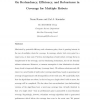Free Online Productivity Tools
i2Speak
i2Symbol
i2OCR
iTex2Img
iWeb2Print
iWeb2Shot
i2Type
iPdf2Split
iPdf2Merge
i2Bopomofo
i2Arabic
i2Style
i2Image
i2PDF
iLatex2Rtf
Sci2ools
91
Voted
RAS
2008
2008
On redundancy, efficiency, and robustness in coverage for multiple robots
Motivated by potential efficiency and robustness gains, there is growing interest in the use of multiple robots for coverage. In coverage, robots visit every point in a target area, at least once. Previous investigations of multi-robot coverage focus on completeness of the coverage, and on eliminating redundancy, but do not formally address robustness. Moreover, a common assumption is that elimination of redundancy leads to improved efficiency (coverage time). We address robustness and efficiency in a novel family of multi-robot coverage algorithms, based on spanning-tree coverage of approximate cell decomposition of the work area. We analytically show that the algorithms are robust, in that as long as a single robot is able to move, the coverage will be completed. We also show that non-redundant (non-backtracking) versions of the algorithms have a worst-case coverage time virtually identical to that of a single robot--thus no performance gain is guaranteed in non-redundant coverage. ...
Related Content
| Added | 28 Dec 2010 |
| Updated | 28 Dec 2010 |
| Type | Journal |
| Year | 2008 |
| Where | RAS |
| Authors | Noam Hazon, Gal A. Kaminka |
Comments (0)

